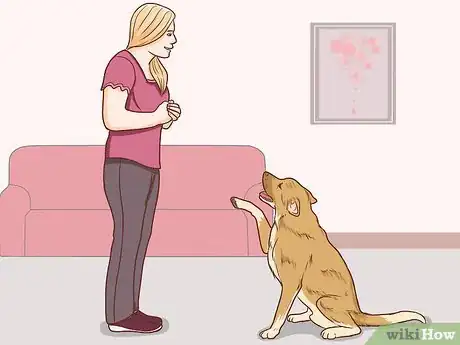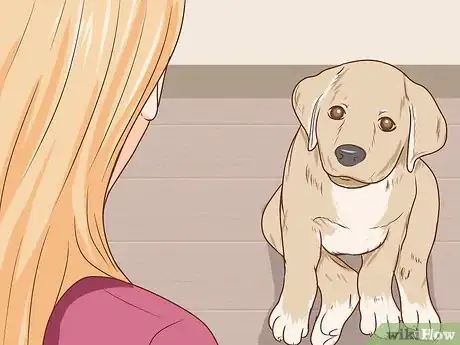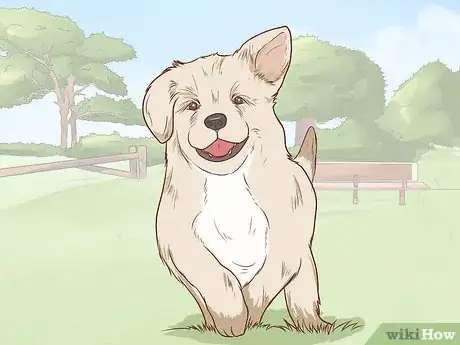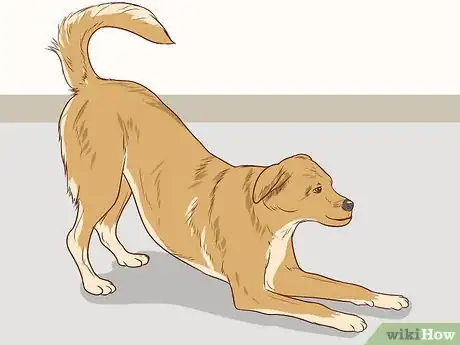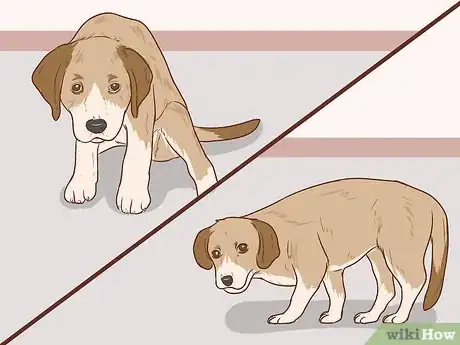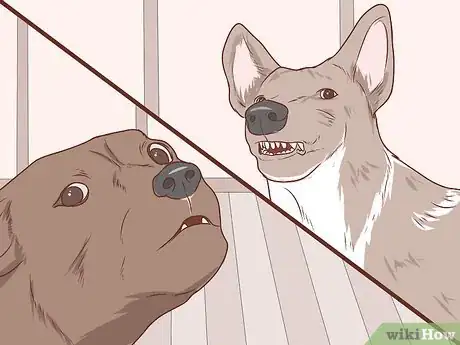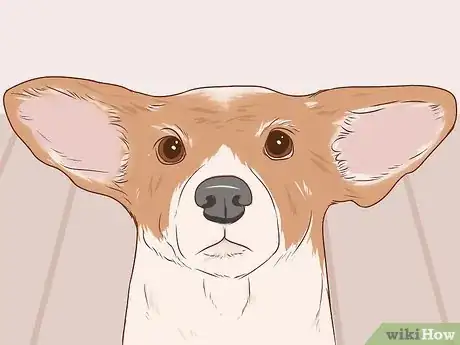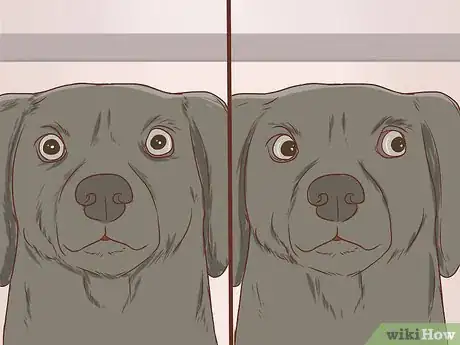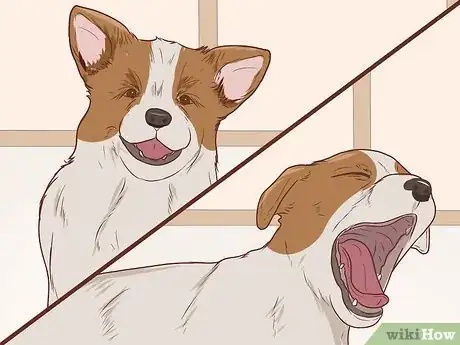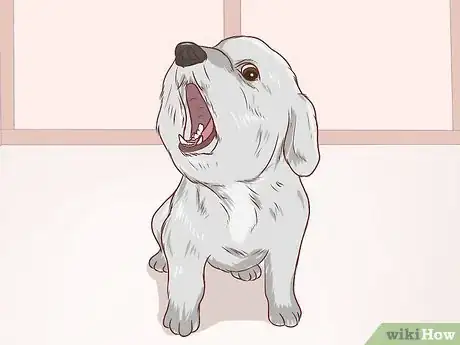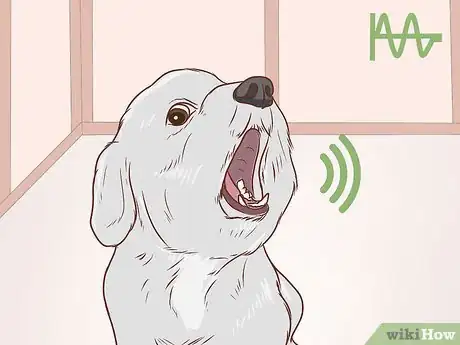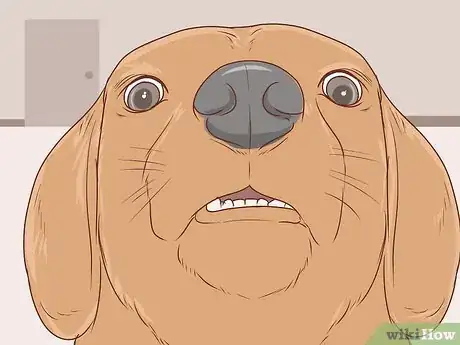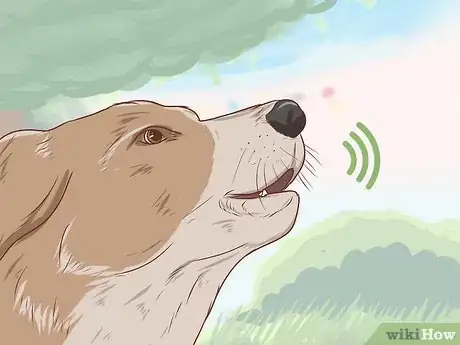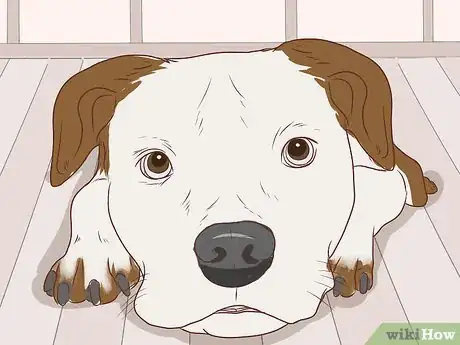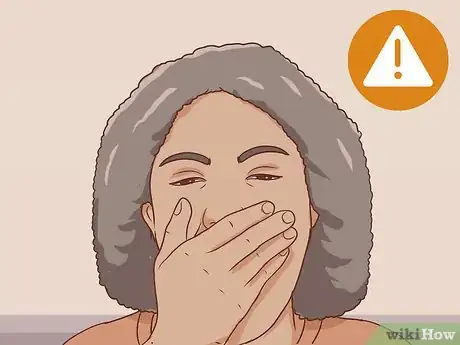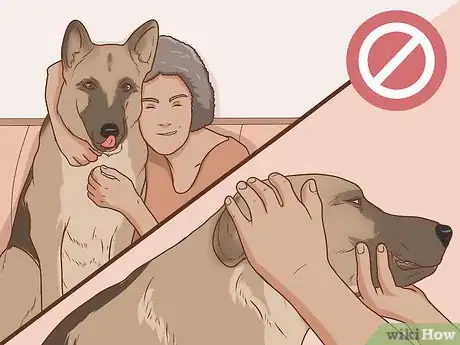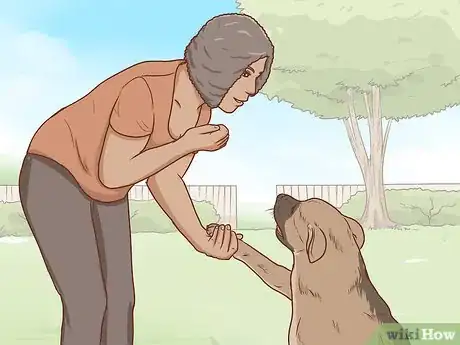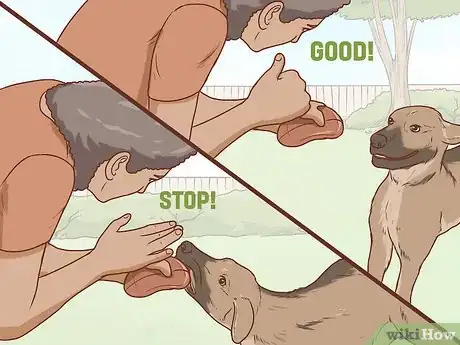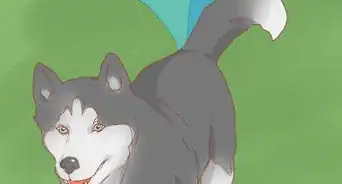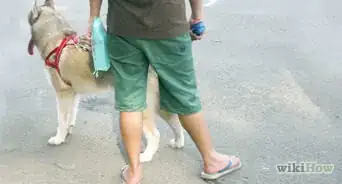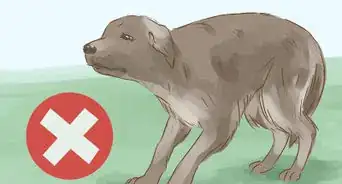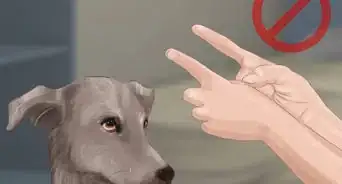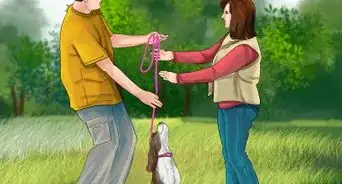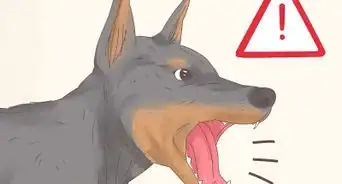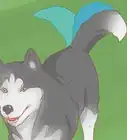This article was co-authored by Star of Texas Veterinary Hospital. Star of Texas Veterinary Hospital is a team of four veterinarians based in Austin, Texas. Star of Texas Veterinary Hospital offers medical assessments, dentistry, ultrasonography, flea control, radiology, and cardiology services to dogs, cats, and pocket pets. Star of Texas Veterinary Hospital is Austin’s first Fear Free Certified Practice and was awarded "1st Runner Up in Culture" by the 2020 Best of the Best Austin Official Choice Awards. They were a Best of the Best winner in Austin's Official Community Choice Awards. Star of Texas Veterinary Hospital's veterinarians are members of the American Association of Feline Practitioners, the Texas Veterinary Medical Association, and the American Veterinary Medical Association.
There are 11 references cited in this article, which can be found at the bottom of the page.
This article has been viewed 1,041,014 times.
Whether you have a new canine companion or you and your dog have been together for a while, it's helpful to know the meaning of your dog's communication signals so that you can adjust your own behavior as needed and so that you can be assured of your dog's feelings. Dogs make vocalizations and gestures using their face and body just as humans do in order to express their feelings. While some of these gestures can appear very similar to human gestures, in dogs, they can have very different meanings. In this article, you'll learn to interpret your dog's various messaging strategies and you'll learn how to communicate more effectively with your canine pal.
Steps
Understanding Dog Behavior
-
1Observe your dog. Learning your dog's habits, mannerisms, and movements through observation will allow the process of understanding its communication behavior to feel more natural. There will be plenty of things it does that will make sense to you without explanation. Just as every person is unique, so is your dog.
- Be aware that much of a dog's language or communication techniques are subtle.
- By learning canine communication, you will be able to respond to any problems your dog expresses before a situation escalates. Not noticing small signs of stress or unhappiness can soon lean to more aggressive or distressed behaviors.
- Remember that this is a two-way learning process. Dogs have to learn our behavioral cues as well, and you should be careful about your own gestures and posture. Dogs also do not understand English. It is important that you teach your dog what you mean by "no" or "sit". Just saying "sit" over and over again won't make him learn it, and will make him think it's just part of the random nonsense you say during the day. Luring your dog into a sit position and then rewarding them heavily for doing that task will make him eager to sit, and then saying the word as he sits will make him connect the dots that the word "sit" means "put your butt on the floor".
- Note that a dog's ability to signal may be hampered by the [Choose the Right Dog Breed to Protect Your Home in question. For example, if your dog has squat ears or a docked tail, some of the signals may not apply to him/her.
-
2Know your dog’s response to eye contact. Consider how you feel when someone stares at you directly rather than using normal eye contact. Just as you find it confronting, dogs also feel confused and threatened by direct head-on staring because it is a threat stance for them. A dog that looks away in this situation is actually being polite and is seeking to avoid confrontation. Alternately, training your dog to make eye contact to communicate is extremely helpful for keeping his focus on you. [1]
- The most effective forms of dog training are positive reinforcement and clicker training. These are the most consistently proven type of training shown by scientists, veterinarians and animal behaviorists. Punishment is frowned upon because it is proven that dogs have very short memories, and likely do not connect situations like them pooping on the floor to your dissatisfaction. In fact, dogs do not feel guilt. Their owners simply stop being as mad when they "look guilty" and it becomes rewarding for both the owner and dog for the dog to offer signs of "guilt". The dog learns you dislike it when poop is on the floor and when you come home, they "act guilty" in order to appease you. They do not in fact relate their action of pooping to you being mad.
- Clicker training is the idea is to lure your dog into a position and indicate instantly they have done the right thing, and reward them for that behavior.
- Dog behavior is driven by the most rewarding or least punishing option they have in every situation. If the most rewarding option is to chew on your shoes, they will do so. If you reward them for not chewing on your shoes, they will choose to do that even when you are not around. In contrast, punishment or dominance suggests showing the dog who is boss, which simply results in the behavior being done when you are not around.
- Dogs are highly reward based and the dominance theory has been disproven. Dogs act in ways that are most rewarding, not based on trying to "dominate" you or another dog. Be the most rewarding thing in your dogs life and he will be eager to do whatever you say.
- Rolling over and exposing the belly is a gesture to appease you, and giving a belly rub serves as excellent reinforcement for this behavior.
- An exposed belly can also indicate passive resistance to a perceived threat.[2]
- Mounting (or humping) can be a sign of stress in a dog, especially where a low-confidence dog is trying to establish allegiance with a higher-confidence animal.
- Dogs use a variety of gestures and postures to express discomfort, including excessive/misplaced sneezing or yawning, licking of the lips, avoiding eye contact, cowering, whale eye (seeing the whites or their eye) and a stiff body. When a dog is showing discomfort, the best thing to do is to stop what you are doing and not do it in the future. If you need your dog to be comfortable with something, make it very rewarding by giving them tons of treats and introducing them to the uncomfortable thing slowly. Soon your pooch will be offering to do those things for a treat!
- A dog can show many emotions with his tail. A wagging tail and wiggly butt mean pure joy. A slowly wagging tail means a cautious nature. A stiff tail held high is a sign of alertness, a low tail is a sign of content. A tucked tail means they are scared.[3]
Reading Your Dog’s Body Language
-
1Learn to interpret your dog's posture. The ways in which a dog holds its body can tell you a great deal about its mood and emotions. Many of the signals will be subtle and it can take some time to learn all of its expressions but it is well worth the effort.
-
2Identify playful and affectionate behavior. Dogs communicate easy confidence and a desire to play through posture and body signals.
- Confident stance: A dog that is feeling confident will stand tall, have its tail up and probably wagging slowly, its ears will either be pricked up or relaxed, and it will generally look relaxed. Its eyes will have smaller pupils as they are also relaxed.
- Bowing: Facing you and with head and chest dipped low to the ground, front legs splayed out, and with rear end and tail up is a clear invitation to play. This is known as the "play bow".[4] It can be mistaken by owners as an attack stance but it clearly denotes playtime.
- Hip swings: Hip swings or nudges are another sign of play.This involves the dog swinging around another dog and knocking them to the ground using the backside (the end of the dog without teeth!).[5] When the dog's rear is presented to you, it is an indication of trust and depending on your dog, it might mean your dog wants a scratch. Wiggling its rear end is a sign of excitement and friendliness.[6]
- If a dog is stretching with his butt in the air, front legs and paws stretched out in front, and head close to the ground, he is probably feeling playful.
- If your dog raises his/her paw to touch your knee or another part of your body, the dog wants to get attention, make a request or ask for something, or indicate a wish to play.[7] The gesture begins as a puppy with kneading associated with obtaining mother's milk[8] but becomes similar to that of offering a hand for a handshake – it's about connecting and friendship.
- Repeatedly pawing at the air is often used by puppies as an invitation to play.
- If a dog’s tail is in a neutral (level with body or slightly lower, he is most likely feeling secure and friendly.[9]
- If your dog’s tail is fiercely wagging and his/her tail up, he/she is feeling mischievous and inclined to bother and annoy you or a fellow canine! It could also signal swatting away another animal.
- If your dog is slowly or slightly wagging his/her tail and watching you, he/she is relaxed but alert and is anticipating, ready to play.
-
3Interpret discomfort or unease. Knowing when your dog is uncomfortable or feeling insecure can help you meet the animal’s needs and provide comfort and reassurance when necessary.
- Pacing can be a sign of nervousness, but it can also be a sign of excitement or boredom. If your dog gets plenty of exercise and entertainment, watch for other signs of nervousness that may accompany the pacing.
- A dog who feels threatened may raise his/her hackles. This tactic, which involves the raising of the strip of fur running down the middle of the dog's back, is a dog’s attempt to make itself appear larger than normal. It is not necessarily an aggressive stance but one of "high alert", making itself ready for whatever may come next. A scared dog can bite, so be extremely careful around a dog raising its hackles.
- A dog who is frightened or insecure may cower or crouch down. A slight crouch can denote submissiveness or nervousness. A similar stance can be an arched back, slightly bent legs, and the tail down (but not tucked under), and looking at what is concerning it.
- A dog raising one paw while keeping most of the body away from the person, animal or object creating uncertainty, and backing away is showing uncertainty or puzzlement. If the dog’s head is tilted to one side, this means that the dog is listening, or is uncertain and puzzled and is awaiting more information.
- A slow tail wag with the tail slightly lowered can indicate that the dog is confused and is asking for an explanation, or is investigating a non-threatening new object.
- If your dog’s tail is slightly lowered and still, he is alert and watching. If the tail is lowered and is barely moving, it can also indicate insecurity.
- If there is slight movement with a low tail, this can indicate that the dog is either sad or not feeling well.
-
4Recognize warning signs of aggression. Aggression may lead to unwanted dog fighting or attacks. Recognizing early warning signs of aggression can help your deescalate a situation before it gets worse.
- A dog whose tail is lowered or tucked between its legs is showing anxiety, fear, and uncertainty.[10] Wagging can still occur in this situation, which can lead to the misunderstanding that the dog is happy. This position can also indicate a need for reassurance or protection.
- A dog that suddenly freezes in the middle of an action is feeling unsure of itself and would rather be left alone, or is preparing for an attack. This is commonplace when a dog is holding a bone; don't get between the dog and its bone!
- If your dog leans forward and appears very rigid, he most likely feels aggressive or threatened. This occurs in response to what the dog perceives as a threat or a challenge. The tail will usually be tucked down or under, or wagging in a quick and frantic manner.
- When a dog is considering an attack or feels threatened, the whites of his/her eyes will likely show as the dog looks at the perceived threat.[11]
- A dog that was showing signs of aggression but who then shakes the head and shoulders may be signaling the end of a certain level of tension, such as being alert to a threat or an anticipated event that doesn't occur.
Recognizing Your Dog’s Face and Head Signals
-
1Understand your dog's ear position. While we're not able to do much with our own ears, a dog's ears can be incredibly expressive. Be aware that dogs whose ears were clipped as a puppy may not have the full range of motion to express themselves through their ears.
- A dog whose ears are pricked forward or straight up is fully engaged in play, hunting, or concentration. This ear position can also indicate curiosity and can express the intent to do something, as the dog is turning to catch sounds. It is an obvious ear position in the early stage of a chase.[12]
- A dog’s ears being flattened, sitting against the dog's head, indicates that the dog feels afraid or threatened. Ears that are forward but close to the head can also indicate aggression.[13]
- A dog’s ears part way back but not flattened may be feeling unhappiness, anxiety, or uncertainty.[14]
-
2Interpret your dog's eye signals. A dog's eyes express as much as human eyes do, and just as you learn to interpret people's eye signals, you can also learn to interpret your dog's. Here are some of the more common eye signals:
- Eyes wide open: this means that your dog is feeling alert, playful, and ready.[15]
- Staring: staring indicates dominant, challenging behavior.
- Avoiding eye contact: a dog trying to look away from your face can be showing politeness, deference, or submission.
- Blinking or winking: these indicate that your dog is being playful.
- Narrowed eyes: this can indicate that your dog is feeling aggressive and is preparing to attack.[16] This gesture may be accompanied by staring.
-
3Watch your dog's face. Dogs often show how they are feeling with facial expressions. Understanding facial expressions can help you interpret your dog’s feelings and communicate with your canine companion.
- Smiling: believe it or not, dogs can smile. While it can be difficult to differentiate a smile from a snarl, checking other body language for signs of play or aggression can help you determine whether your dog is happy or feeling aggressive. If everything else adds up to a happy dog, then your dog is smiling, and this means it's happy and relaxed.
- Yawning: the meaning of a dog’s yawning is dependent on the context, just as it is with humans (humans yawn because we're tired, need more oxygen, we're feeling stressed or embarrassed, or we notice someone else yawning). For dogs, yawning appears to be contagious just as it is with humans.[17] Indeed, if you yawn in front of your dog, it may interpret it either as you being stressed (in which case, it will likely turn away from you to give you some space), or it will respond in kind and yawn too.[18] Dogs also yawn as a way to ease tension, to show confusion or when they feel slightly threatened especially when meeting new situations or new dogs or animals.
- Mouth position: a dog that has its mouth stretched back, closed or just slightly open, is showing that it is very stressed, in fear, or in pain.[19] This may be accompanied by rapid panting. If its mouth is stretched back and open, it is a neutral or submissive sign. A dog that is alert and content will have its mouth closed or slightly open, with the teeth covered.[20]
- Lip licking: if your dog licks its lips in combination with a yawn, this can be a clear indication that it is feeling stressed, under pressure, or facing a threat.[21] It's a commonplace gesture shown by puppies around adults, but the behavior should not continue into adulthood. In mature dogs, licking can also be part of the dog's sexual behavior as it finds chemical signals on grass, carpet, and the genitals of other dogs.[22] A dog that is licking another dog's lips is showing deferring behavior.
- Bared teeth: a dog whose lips are curled out and his teeth bared is signaling aggression and an intention to use the teeth for biting. This doesn't mean that every flash of teeth means aggression though, and you must take care to note the other elements. If the teeth are bared and there is no wrinkling of the muzzle, this is a warning and a sign of dominance and territorial defensiveness. If the lips are curled, the teeth are bared, the muzzle is wrinkled, and the dog is snarling, this indicates that the dog is angry and ready to fight, and there is every chance that it will bite.
Interpreting Your Dog’s Vocalizations
-
1Listen to your dog. Barks, growls, yelps, and howls all carry their own unique language indicators that can take time to learn but are also an important part of understanding your dog's overall behavior. Many people think a bark is a bark. As you begin to really listen you will hear very distinct differences in the types of vocalizations.
- Note that a lack of barking or other dog noises can indicate a predatory state, aimed at not alerting the prey. This may also be accompanied by sniffing the air, keeping low, remaining rigid, ears flicking forward and backward to catch sounds, mouth closed and eyes wide open.[23] Equally, no noise can indicate a submissive dog seeking approval.
-
2Recognize your dog’s barks. Dogs bark for different reasons, and observation and listening can help you learn to differentiate your dog's distinctive barks in different situations.
- A loud, high pitched, rapid bark can be either aggressive or territorial.[24]
- A short, frequent guttural alert bark is aimed at warning the pack (wolf or human) of potential danger. It may be accompanied by snarling or growling.[25]
- A crisp, short bark is usually a form of greeting from your dog.
- A high-pitched bark is often delivered when your dog is being playful. A short, high bark is a sign of friendliness, and may be accompanied by whimpering or yapping.[26]
- A sudden high-pitched, sharp yelp may be an indication that your dog is in pain.
- A low-pitched, single or spaced out bark is another warning to back off.
-
3Interpret your dog’s growls. Growling in a strange dog can be somewhat frightening, but not every growl is aggressive. Your dog may growl as part of play or as an alternative form of verbal communication to barking. You should use caution, however, with any dog growls because even a playing dog that has become too boisterous and carried away in play may still snap at a human who intervenes or gets too close.
- A low, quiet growl indicates that the subject of the growl needs to back off. It is a sign of assertiveness in a dominant dog.[27]
- A low growl ending with short bark is the sound made when your dog is responding to threat. It can be a prelude to a snap.
- A medium growl, leading to or combined with bark indicates that your dog feels nervous, and possibly aggressive. You should proceed with caution.
- Low sustained growl or 'woofing' is an indication that your dog is feeling either anxious or suspicious.
- A low murmuring grumble is a lovely sign of contentment. Soft growling is generally play growling;[28] assess it by taking in the context and the general stance of your dog. Play growling will often be accompanied by excited barking.
-
4Understand why dogs howl. Knowing the different reasons that your dog may howl can help you respond to his/her needs. There are several different kinds of howling that have different meanings.
- A long, sustained howl indicates separation or loneliness. If your new dog or puppy was separated from other dogs to join your home, he/she may howl at first. Keeping his/her close to you can help him/her feel less lonely.
- A short howl with rising pitch generally signals that your dog is happy and/or excited.
- Baying is a hunting signal and can be common in breeds who are bred to hunt, even if your dog has never had any training as a hunting dog.
- A siren howl is a response to another howl or a sustained noise. You may notice that your dog howls in response to sirens going by your home. If your dog howls at night, he may be howling in response to other dog howling that is out of the range of human hearing.
-
5Learn to differentiate whines and whimpers. Another type of vocalization given by dogs is whining. Like barking, howling, and growling, whining or whimpering may mean different things in different contexts.
- Short whines accompanied by short barks indicate that your dog is eager, curious, and excited.[29]
- Short whimpers are often a sign of fear or anxiety.
- A low-pitched whine indicates that your dog is mildly anxious or submissive.[30]
- A persistent, high-pitched whine can be a plea for attention, reflect intense anxiety, or indicate severe discomfort or pain.
Expressing Human Communication
-
1Avoid unintentional signals. Dogs understand your language to some extent, but it's very important to understand how you appear to your dog and how some of your gestures may be causing your dog distress, fear, or worry, even though you're completely unaware of this. Always be aware that your dog is watching you, learning, and seeking to predict your routine, habits, and preferences. [31]
- Withdrawal of your gaze and your arms at the same time informs your dog that you have decided not to touch him/her anymore and he/she may respond negatively.[32]
- Yawning can indicate to your dog that you're distressed and cause him/her to move away from you. It can be a good idea to cover your yawn around your dog if he/she seems to respond negatively to the action.
-
2Prevent your dog’s discomfort. Some actions that we see as normal or loving do not translate well from “human language” to “dog language.” Avoiding activities that make dogs uncomfortable can help strengthen your relationship with your pet.
- Staring at your dog can be viewed as a threat. Some trainers used to believe that a dog looking away from a stare was showing disobedience, but it is better understood now as being a sign of politeness or submission.[33]
- Punishing or reacting negatively to signs of fear in a dog will serve only to increase the dog's sense of fear and does nothing to instill better behavior from our perspective. Do not interpret signs of discomfort or fear as signs of guilt.
- Many dogs do not like being patted directly on the head. However, this is something a dog usually needs to learn to tolerate.[34] You should never pat a strange dog on the head until you're more familiar with it, but if you live in an urban environment where people are likely to want to pet your dog, early training (with treats) to help your dog tolerate head patting is essential.
- Hugging and cuddling is often another action that dogs do not like. Nature has programmed the dog to believe that being held in close proximity means one of two things: one, that it is trapped as prey, or two, that it is being mounted.[35] Since neither of these actions brings on happy responses, a dog that is not used to frequent cuddling and hugging may respond by fleeing, wriggling, and snapping. If this is the case with your dog, be patient and take a gradual approach to getting it used to a loving embrace. Ensure that children who hug dogs always keep their faces away from the dog, and monitor the dog's reaction so that you can intervene quickly if needed.
- Dogs are social animals and need contact, so you should avoid making them feel overly isolated. The first nights of having a puppy in the home are essential. Try to stay near the puppy (such as having its crate in your room), then gradually move his/her to where he/she will sleep permanently. This will reassure the dog that all is well. Do not share your bed with a dog unless you want this to become a permanent arrangement. Doing this creates a permanent expectation in your puppy's mind.
-
3Clarify intentional commands. Being clear, consistent, and concise with your commands and direct communication with your dog can help your dog understand what you want him to do. Most dogs want to please their owners, so they will try to adapt their behavior to your expectations.
- Always repeat commands using the same words and tone so that your dog knows his name and understands that he should be listening to you.
- Alter your tone when communicating different emotions to your dog. Dogs have instincts that help them discern if we are happy with them or upset with them. If you smile and tell your dog good dog in a happy tone, he will know that he has done something right. Likewise, if you correct him in an angry tone, he will know that he has done something wrong. This is an important thing to take in consideration when training.
- Remember that dogs forget things frequently. However, they will remember things that they have been trained about, where certain things and people are, who you are and who their friends are, getting praised, and surprising things (good or bad) that happen.
- Shouting at your dog, gesticulating wildly, or shaking "weapons" like a broomstick at your dog will seem like crazy behavior and does nothing to change your dog's behavior. It can, however, upset an already insecure and fearful dog even more. Spare your energy and stay calm. Keep your communication tactics clear and reasoned.
- Keep this in mind while correcting a dog. If you come home to a destroyed sofa, yelling at the dog will not achieve anything, as the dog will not make the connection between the destroyed sofa and the correction.
-
4Develop mutual communication. Having a 2-way communication relationship with your dog will help both of you maintain a healthy relationship. Keeping the lines of communication open and showing your dog that you understand his/her will help you know when to step in if something is wrong.
- Research how dogs communicate with each other. Modeling your own communication strategy on dog-to-dog communication can lead to more successful communication.
Expert Q&A
-
QuestionHow do you tell a dog you love them?
 Pippa Elliott, MRCVSDr. Elliott, BVMS, MRCVS is a veterinarian with over 30 years of experience in veterinary surgery and companion animal practice. She graduated from the University of Glasgow in 1987 with a degree in veterinary medicine and surgery. She has worked at the same animal clinic in her hometown for over 20 years.
Pippa Elliott, MRCVSDr. Elliott, BVMS, MRCVS is a veterinarian with over 30 years of experience in veterinary surgery and companion animal practice. She graduated from the University of Glasgow in 1987 with a degree in veterinary medicine and surgery. She has worked at the same animal clinic in her hometown for over 20 years.
Veterinarian Speak to your dog and tell them you love them. They will understand and love you back for it.
Speak to your dog and tell them you love them. They will understand and love you back for it. -
QuestionHow do you teach your dog to talk?
 Pippa Elliott, MRCVSDr. Elliott, BVMS, MRCVS is a veterinarian with over 30 years of experience in veterinary surgery and companion animal practice. She graduated from the University of Glasgow in 1987 with a degree in veterinary medicine and surgery. She has worked at the same animal clinic in her hometown for over 20 years.
Pippa Elliott, MRCVSDr. Elliott, BVMS, MRCVS is a veterinarian with over 30 years of experience in veterinary surgery and companion animal practice. She graduated from the University of Glasgow in 1987 with a degree in veterinary medicine and surgery. She has worked at the same animal clinic in her hometown for over 20 years.
Veterinarian Dogs already talk through their facial expressions, body language, and range of vocalizations. Rather than teach a dog to talk, we should learn to speak dog!
Dogs already talk through their facial expressions, body language, and range of vocalizations. Rather than teach a dog to talk, we should learn to speak dog! -
QuestionHow do you know what your dog is saying?
 Pippa Elliott, MRCVSDr. Elliott, BVMS, MRCVS is a veterinarian with over 30 years of experience in veterinary surgery and companion animal practice. She graduated from the University of Glasgow in 1987 with a degree in veterinary medicine and surgery. She has worked at the same animal clinic in her hometown for over 20 years.
Pippa Elliott, MRCVSDr. Elliott, BVMS, MRCVS is a veterinarian with over 30 years of experience in veterinary surgery and companion animal practice. She graduated from the University of Glasgow in 1987 with a degree in veterinary medicine and surgery. She has worked at the same animal clinic in her hometown for over 20 years.
Veterinarian Understanding what a dog is saying is about learning to read their body language and putting it in context. This involves reading about the fields of dog behavior and animal psychology, which are hugely satisfying subjects to study.
Understanding what a dog is saying is about learning to read their body language and putting it in context. This involves reading about the fields of dog behavior and animal psychology, which are hugely satisfying subjects to study.
Warnings
- While approaching unknown dogs on the street or anywhere, understand that you must always be above their eye level but never in a threatening way for they may become scared and attack. Speaking to them while in this position can help you remain safe.⧼thumbs_response⧽
- Do not force your dog into doing anything, and do not communicate with it in a way that could come off harmful or offensive.⧼thumbs_response⧽
- Note! Any whine or whimper can mean pain or injury. Do not ignore any sustained whining or whimpering if the cause is not known. Give your dog a thorough check over, and if you still cannot find anything wrong and he/she continues to voice his/her unhappiness, see a vet as soon as possible.⧼thumbs_response⧽
- As clarified in the article's steps, be aware that a wagging tail does not necessarily mean that the dog is friendly or happy. Dogs can wag their tails for many reasons (just as humans can smile or show their teeth for many reasons). If you're not familiar with the dog, always look for other signs that may suggest he/she is not in the mood for handling or that a swift retreat is in order.⧼thumbs_response⧽
References
- ↑ Sarah Whitehead, The City Dog: The Essential Guide for the Urban Owner, pp. 26-27, (2008), ISBN 978-0-600-61724-2
- ↑ Sarah Whitehead, The City Dog: The Essential Guide for the Urban Owner, p. 33, (2008), ISBN 978-0-600-61724-2
- ↑ Star of Texas Veterinary Hospital. Veterinarians.
- ↑ Sarah Whitehead, The City Dog: The Essential Guide for the Urban Owner, p. 30, (2008), ISBN 978-0-600-61724-2
- ↑ Sarah Whitehead, The City Dog: The Essential Guide for the Urban Owner, p. 30, (2008), ISBN 978-0-600-61724-2
- ↑ Paws Across America, How to interpret your dog's body language, facial expressions, and vocalizations, http://www.pawsacrossamerica.com/interpret.html
- ↑ Sarah Whitehead, The City Dog: The Essential Guide for the Urban Owner, p. 30, (2008), ISBN 978-0-600-61724-2
- ↑ Sarah Whitehead, The City Dog: The Essential Guide for the Urban Owner, p. 30, (2008), ISBN 978-0-600-61724-2
- ↑ Sarah Whitehead, The City Dog: The Essential Guide for the Urban Owner, p. 34, (2008), ISBN 978-0-600-61724-2
- ↑ Sarah Whitehead, The City Dog: The Essential Guide for the Urban Owner, p. 34, (2008), ISBN 978-0-600-61724-2
- ↑ Star of Texas Veterinary Hospital. Veterinarians.
- ↑ Paws Across America, How to interpret your dog's body language, facial expressions, and vocalizations, http://www.pawsacrossamerica.com/interpret.html
- ↑ Paws Across America, How to interpret your dog's body language, facial expressions, and vocalizations, http://www.pawsacrossamerica.com/interpret.html
- ↑ Paws Across America, How to interpret your dog's body language, facial expressions, and vocalizations, http://www.pawsacrossamerica.com/interpret.html
- ↑ Paws Across America, How to interpret your dog's body language, facial expressions, and vocalizations, http://www.pawsacrossamerica.com/interpret.html
- ↑ Paws Across America, How to interpret your dog's body language, facial expressions, and vocalizations, http://www.pawsacrossamerica.com/interpret.html
- ↑ Sarah Whitehead, The City Dog: The Essential Guide for the Urban Owner, p. 32, (2008), ISBN 978-0-600-61724-2
- ↑ Sarah Whitehead, The City Dog: The Essential Guide for the Urban Owner, p. 32, (2008), ISBN 978-0-600-61724-2
- ↑ Paws Across America, How to interpret your dog's body language, facial expressions, and vocalizations, http://www.pawsacrossamerica.com/interpret.html
- ↑ Paws Across America, How to interpret your dog's body language, facial expressions, and vocalizations, http://www.pawsacrossamerica.com/interpret.html
- ↑ Sarah Whitehead, The City Dog: The Essential Guide for the Urban Owner, p. 32, (2008), ISBN 978-0-600-61724-2
- ↑ Sarah Whitehead, The City Dog: The Essential Guide for the Urban Owner, p. 32, (2008), ISBN 978-0-600-61724-2
- ↑ Paws Across America, How to interpret your dog's body language, facial expressions, and vocalizations, http://www.pawsacrossamerica.com/interpret.html
- ↑ Paws Across America, How to interpret your dog's body language, facial expressions, and vocalizations, http://www.pawsacrossamerica.com/interpret.html
- ↑ Paws Across America, How to interpret your dog's body language, facial expressions, and vocalizations, http://www.pawsacrossamerica.com/interpret.html
- ↑ Paws Across America, How to interpret your dog's body language, facial expressions, and vocalizations, http://www.pawsacrossamerica.com/interpret.html
- ↑ Paws Across America, How to interpret your dog's body language, facial expressions, and vocalizations, http://www.pawsacrossamerica.com/interpret.html
- ↑ Paws Across America, How to interpret your dog's body language, facial expressions, and vocalizations, http://www.pawsacrossamerica.com/interpret.html
- ↑ Paws Across America, How to interpret your dog's body language, facial expressions, and vocalizations, http://www.pawsacrossamerica.com/interpret.html
- ↑ Paws Across America, How to interpret your dog's body language, facial expressions, and vocalizations, http://www.pawsacrossamerica.com/interpret.html
- ↑ Sarah Whitehead, The City Dog: The Essential Guide for the Urban Owner, p. 26, (2008), ISBN 978-0-600-61724-2
- ↑ Jo Navarro and Marvin Karlins, What Every Body is Saying, p. 118, (2008), ISBN 978-006-1438-295
- ↑ Sarah Whitehead, The City Dog: The Essential Guide for the Urban Owner, p. 27, (2008), ISBN 978-0-600-61724-2
- ↑ Sarah Whitehead, The City Dog: The Essential Guide for the Urban Owner, p. 29, (2008), ISBN 978-0-600-61724-2
- ↑ Sarah Whitehead, The City Dog: The Essential Guide for the Urban Owner, p. 34, (2008), ISBN 978-0-600-61724-2
About This Article
To communicate with your dog, learn how to interpret its body language so you'll know when your dog is feeling happy, playful, afraid, or angry and can react appropriately to its needs. Additionally, get to know your dog's eye signals, ear positions, and facial expressions to understand your dog's moods. You can also communicate directly with your dog by training it to understand and respond to your verbal commands. Remember to be clear, consistent, and concise with your commands for the best results! For tips on interpreting dog vocalizations like barking, read on!
